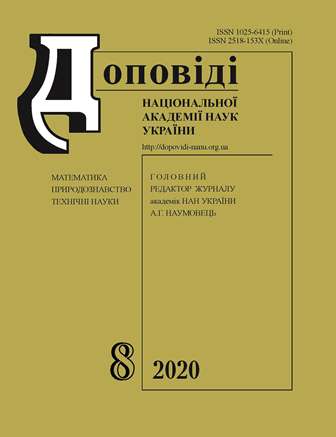Вплив екзогенної обробки водним розчином сигнальної молекули-медіатора бактеріального походження n-гексаноїл-l-гомосеринлактону (C6-ГГЛ) на морфологічні та фізіологічні реакції озимої пшениці за умов дії модельованого кислотного дощу
DOI:
https://doi.org/10.15407/dopovidi2020.07.092Ключові слова:
N-гексаноїл-L-гомосеринлактон, Triticum aestivum, кислотний дощ, клітинна стінка, мікроструктура епідермісу, фотосинтетичні пігментиАнотація
This research aims to investigate the influence of foliar treatment by bacterial quorum sensing signal molecule/messenger N-hexanoyl-L-homoserine lactone (C6-HSL, 100 ng/ml) on morphological and functional characteristics of Triticum aestivum L. cv. Yatran 60 leaves under simulated acid rain (SAR). Acid rain is one of the most dangerous abiotic stressor, which negatively affects the plant growth and development. It changes the permeability and photochemical activity of membranes, leads to the disruption of a chloroplast ultrastructure, stomata system functioning, reduces CO2 photofixation. Using the scanning electron microscopy, we identified that, after the foliar treatment by C6-HSL, the thickness of the leaf cell wall along with the cuticle layer in 20-day-old plants increased by 15 %. Under SAR condition, the plants have suffered the disruption of the cuticular wax layer and uneven wax plates on the epidermis surface, whereas the plants treated with C6-HSL showed only a partial cracking of the cuticular wax layer, slight disruption of wax plates, and formation of a wax shell. The C6-HSL-treated plants showed the normal functioning of stomata guard cells and the stabilization in the content of photosynthetic pigments. The protective effect of the foliar treatment with C6-HSL solution in winter wheat plants under SAR and perspective of its using for the induction of stress resistance has been discussed.
Завантаження
Посилання
Burns, D. A., Aherne, J., Gay, D. A., & Lehmann, Ch. M. B. (2016). Acid rain and its environmental effects: Recent scientific advances. Atmos. Environ., 146, pp. 1-4. https://doi.org/10.1016/j.atmosenv.2016.10.019
Singh, A. & Agrawal, M. (2008). Acid rain and its ecological consequences. J. Environ. Biol., 29, No. 1, pp. 15-24. 3. Lal, N. (2016). Effects of acid rain on plant growth and development. J. Sci. Technol., 11, No. 5, pp. 85-101.
Velikova, V., Tsonev, T. & Yordanov, I. (2002). Light and CO2 responses of photosynthesis and chlorophyll fluorescence characteristics in bean plants after simulated acid rain. Physiol. Plant., 107, No. 1, pp. 77-83. https://doi.org/10.1034/j.1399-3054.1999.100111.x
Polishchuk, O. V., Vodka, M. V., Belyavskaya, N. A., Khomochkin, A. P. & Zolotareva, E. K. (2016). The effect of acid rain on ultrastructure and functional parameters of photosynthetic apparatus in pea leaves. Cell Tiss. Biology, 10, No. 3, pp. 250-257. https://doi.org/10.1134/S1990519X16030093
Yu, J-Q., Ye, S.-F. & Huang, L.-F. (2002). Effects of simulated acid precipitation on photosynthesis, chlorophyll fluorescence, and antioxidative enzymes in Cucumis sativus L. Photosynthetica, 40, No. 3, pp. 331-335. https://doi.org/10.1023/A:1022658504882
Babenko, L. M., Moshynets, O. V., Shcherbatiuk, M. M. & Kosakivska, I. V. (2016). Bacterial acyl homoserine lactones in plant priming biotechnology: achievements and prospects of use in agricultural production. Plant Physiol. Genet., 48, No. 6, pp. 463-474. https://doi.org/10.15407/frg2016.06.463
Schenk, S. T., Hernández-Reyes, C., Samans, B., Stein, E., Neumann, C., Schikora, M., Reichelt, M., Mithöfer, A., Becker, A., Kogel, K. H., & Schikora, A. (2014). N-acyl-homoserine lactone primes plants for cell wall reinforcement and induces resistance to bacterial pathogens via the salicylic acid/oxylipin pathway. Plant Cell, 26, No. 6, pp. 2708-2723. https://doi.org/10.1105/tpc.114.126763
Moshynets, O. V., Babenko, L. M., Rogalsky, S. P., Iungin, O. S., Foster, J., Kosakivska, I.V., Potters, G. & Spiers, A. (2019). Priming winter wheat seeds with the bacterial quorum sensing signal N-hexanoyl- Lhomoserine lactone (C6-HSL) shows potential to improve plant growth and seed yield. PLoS One, 14, No. 2, e0209460. https://doi.org/10.1371/journal. pone.0209460
Wellburn, A. (1994). The spectral determination of chlorophyll a and chlorophyll b, as well as total carotenoids, using various solvents with spectrophotometers of different resolution. J. Plant Physiol., 144, No. 3, pp. 307-313. https://doi.org/10.1016/S0176-1617(11)81192-2
Müller, C. (2006). Plant — insect interactions on cuticular surfaces. In Biology of the Plant Cuticle (pp. 398-422), Blackwell, Oxford. https://doi.org/10.1002/9780470988718.ch13
Wagner, P., Fürstner, R., Barthlott, W. & Neinhuis, C. (2003). Quantitative assessment to the structural basis of water repellency in natural and technical surfaces. J. Exp. Bot., 54, No. 385, pp. 1295-1303. https://doi.org/10.1093/jxb/erg127
Dvinskikh, S. A., Maksimovich, N. G., Maleev, K. I. & Larchenko, O. V. (2011). Ekologiya lesoparkovoi zony goroda [Ecology of the urban parkland]. St. Petersburg: Nauka Publ. (in Russian).
Du, E., Dong, D., Zeng, X., Sun, Z., Jiang, X. & Vries, W. (2017). Direct effect of acid rain on leaf chlorophyll content of terrestrial plants in China. Sci. Total Environ., 605-606, pp. 764-769. https://doi.org/10.1016/j.scitotenv.2017.06.044
Vicas, S. I., Grosu, E. & Laslo, V. (2015). The effects of simulated acid rain on growth and biochemistry process in grass (Lolium perenne). Lucrări Ştiinţifice, 52, seria Agronomie, pp. 227-283.
##submission.downloads##
Опубліковано
Як цитувати
Номер
Розділ
Ліцензія
Авторське право (c) 2023 Доповіді Національної академії наук України

Ця робота ліцензується відповідно до Creative Commons Attribution-NonCommercial 4.0 International License.




